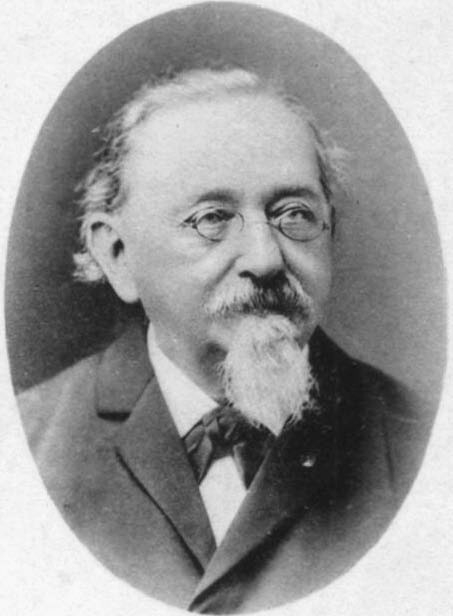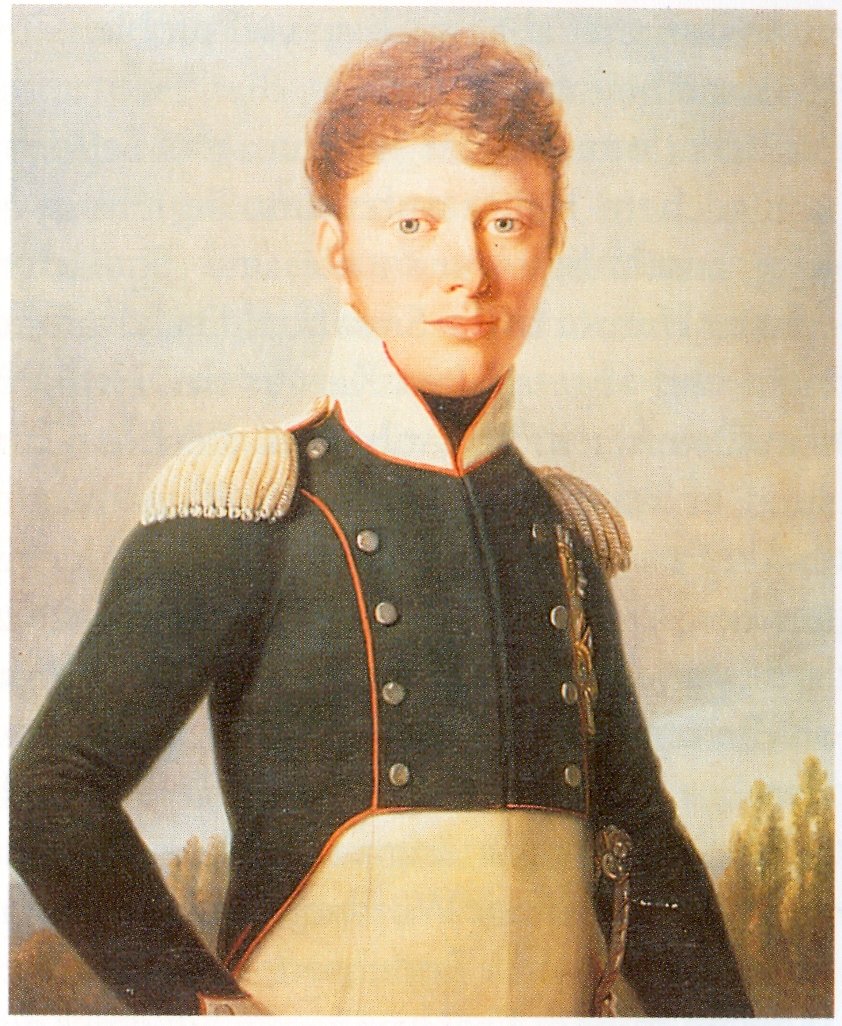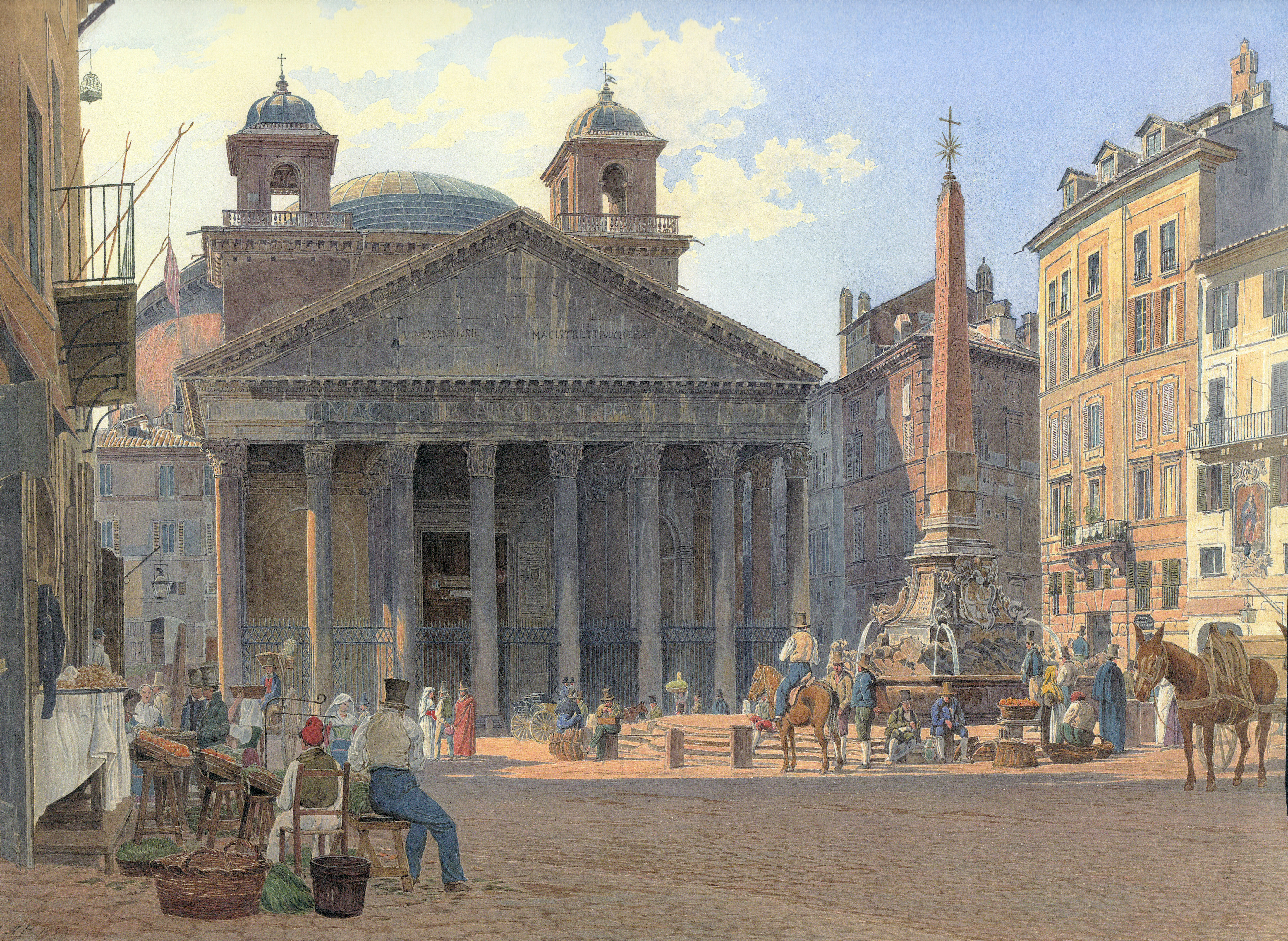|
Johann Michael Knapp
Johann Michael Knapp (10 March 1791, Stuttgart - 22 October 1861, Stuttgart) was a German court architect in Württemburg. Biography His father, also named Johann Michael, originally came from Ditzingen and was a Master baker. His mother, Elisabetha, née Bauder was from Waiblingen. From 1808 to 1809, he attended the Polytechnic School in Karlsruhe ( now part of the Karlsruhe Institute of Technology). After 1815, he pursued his artistic studies with Johann Heinrich von Dannecker. This was followed by an apprenticeship in Milan (1818). He lived in Rome from 1819 to 1840. There, he was a member of the local , also known as the "Ponte Molle Society". He continued to design projects for his hometown. In 1820, together with Giovanni Salucci, he drew the construction plans for the Württemberg Mausoleum; on commission from Queen Katharina Pawlowna. A trip to Naples in 1821 took him to Pompeii. Later, from 1829 to 1832, he worked on researching and illustrating ancient Etruscan ... [...More Info...] [...Related Items...] OR: [Wikipedia] [Google] [Baidu] |
Etruscan Civilization
The Etruscan civilization () was developed by a people of Etruria in ancient Italy with a common language and culture who formed a federation of city-states. After conquering adjacent lands, its territory covered, at its greatest extent, roughly what is now Tuscany, western Umbria, and northern Lazio, as well as what are now the Po Valley, Emilia-Romagna, south-eastern Lombardy, southern Veneto, and western Campania. The earliest evidence of a culture that is identifiably Etruscan dates from about 900BC. This is the period of the Iron Age Villanovan culture, considered to be the earliest phase of Etruscan civilization, which itself developed from the previous late Bronze Age Proto-Villanovan culture in the same region. Etruscan civilization endured until it was assimilated into Roman society. Assimilation began in the late 4thcenturyBC as a result of the Roman–Etruscan Wars; it accelerated with the grant of Roman citizenship in 90 BC, and became complete in 27 BC, when the Etr ... [...More Info...] [...Related Items...] OR: [Wikipedia] [Google] [Baidu] |
19th-century German Architects
The 19th (nineteenth) century began on 1 January 1801 ( MDCCCI), and ended on 31 December 1900 ( MCM). The 19th century was the ninth century of the 2nd millennium. The 19th century was characterized by vast social upheaval. Slavery was abolished in much of Europe and the Americas. The First Industrial Revolution, though it began in the late 18th century, expanding beyond its British homeland for the first time during this century, particularly remaking the economies and societies of the Low Countries, the Rhineland, Northern Italy, and the Northeastern United States. A few decades later, the Second Industrial Revolution led to ever more massive urbanization and much higher levels of productivity, profit, and prosperity, a pattern that continued into the 20th century. The Islamic gunpowder empires fell into decline and European imperialism brought much of South Asia, Southeast Asia, and almost all of Africa under colonial rule. It was also marked by the collapse of the large S ... [...More Info...] [...Related Items...] OR: [Wikipedia] [Google] [Baidu] |
1861 Deaths
Statistically, this year is considered the end of the whale oil industry and (in replacement) the beginning of the petroleum oil industry. Events January–March * January 1 ** Benito Juárez captures Mexico City. ** The first steam-powered carousel is recorded, in Bolton, England. * January 2 – Friedrich Wilhelm IV of Prussia dies, and is succeeded by Wilhelm I. * January 3 – American Civil War: Delaware votes not to secede from the Union. * January 9 – American Civil War: Mississippi becomes the second state to secede from the Union. * January 10 – American Civil War: Florida secedes from the Union. * January 11 – American Civil War: Alabama secedes from the Union. * January 12 – American Civil War: Major Robert Anderson sends dispatches to Washington. * January 19 – American Civil War: Georgia secedes from the Union. * January 21 – American Civil War: Jefferson Davis resigns from the United States Senate. * January 26 ... [...More Info...] [...Related Items...] OR: [Wikipedia] [Google] [Baidu] |
1791 Births
Events January–March * January 1 – Austrian composer Joseph Haydn arrives in England, to perform a series of concerts. * January 2 – Northwest Indian War: Big Bottom Massacre – The war begins in the Ohio Country, with this massacre. * January 12 – Holy Roman troops reenter Liège, heralding the end of the Liège Revolution, and the restoration of its Prince-Bishops. * January 25 – The British Parliament passes the Constitutional Act 1791, splitting the old province of Quebec into Upper and Lower Canada. * February 8 – The Bank of the United States, based in Philadelphia, is incorporated by the federal government with a 20-year charter and started with $10,000,000 capital.''Harper's Encyclopaedia of United States History from 458 A. D. to 1909'', ed. by Benson John Lossing and, Woodrow Wilson (Harper & Brothers, 1910) p169 * February 21 – The United States opens diplomatic relations with Portugal. * March 2 – Fr ... [...More Info...] [...Related Items...] OR: [Wikipedia] [Google] [Baidu] |
Christian Friedrich Von Leins
Christian Friedrich von Leins (22 November 1814 in Stuttgart – 25 August 1892 in Stuttgart) was a German architect. Life He was the son of masonry foreman. Until 1837, Leins attended the Friedrich-Eugens-Gymnasium in Stuttgart, then served an apprenticeship at a local architectural firm. From 1837 to 1840, he lived in Paris, where he found employment with Henri Labrouste, while he received training from Eugène Flachat and Jules Petiet. Upon returning home, he passed the state exam for structural engineering. He made trips to Bavaria and Austria in 1843, to study the Medieval and Renaissance architecture there. His work on a new building for the Russian Legation impressed the Crown Prince, so Leins was contracted to design the "Villa Berg", a new royal residence. In 1846, he accompanied the Prince's entourage to Palermo, seeking inspiration from the structures there. In 1853, he undertook another study trip to Italy, Spain and North Africa with Friedrich Wilhelm Hac ... [...More Info...] [...Related Items...] OR: [Wikipedia] [Google] [Baidu] |
Königsbau
The Königsbau is one of the formative buildings of Stuttgart's Schlossplatz. It forms the north-west end of the square and is mainly home to shops and cafés. Since April 2006, the Königsbau-Passagen, a 45,000 square meter retail and commercial building, has been attached to the rear of the Königsbau. History The Königsbau was built between 1856 and 1860 by order of King Wilhelm I in late classicist style as a business, concert and ball house. The royal court architect Christian Friedrich von Leins together with architect Johann Michael Knapp were awarded the building contract. After Knapp retired from work in 1857, partly for health reasons, Leins completed the construction. The official inauguration took place in September 1860. Two years earlier, Wilhelm I had already given permission for the project to be called the Königsbau. The monumental building was intended to form a counterpoint to the New Palace and is characterized by a colonnade consisting of 34 columns ... [...More Info...] [...Related Items...] OR: [Wikipedia] [Google] [Baidu] |
Relief
Relief is a sculptural method in which the sculpted pieces are bonded to a solid background of the same material. The term ''relief'' is from the Latin verb ''relevo'', to raise. To create a sculpture in relief is to give the impression that the sculpted material has been raised above the background plane. When a relief is carved into a flat surface of stone (relief sculpture) or wood (relief carving), the field is actually lowered, leaving the unsculpted areas seeming higher. The approach requires a lot of chiselling away of the background, which takes a long time. On the other hand, a relief saves forming the rear of a subject, and is less fragile and more securely fixed than a sculpture in the round, especially one of a standing figure where the ankles are a potential weak point, particularly in stone. In other materials such as metal, clay, plaster stucco, ceramics or papier-mâché the form can be simply added to or raised up from the background. Monumental bronze reliefs a ... [...More Info...] [...Related Items...] OR: [Wikipedia] [Google] [Baidu] |
William I Of Württemberg
William I (german: Friedrich Wilhelm Karl; 27 September 178125 June 1864) was King of Württemberg from 30 October 1816 until his death. Upon William's accession, Württemberg was suffering crop failures and famine in the "Year Without a Summer", in 1816. After taking office, he initiated sweeping reforms, resulting in the approval of the Estates of Württemberg to a constitution on 25 September 1819. In his 48-year reign, the kingdom moved from one that was created from different denominational principalities and a heterogeneous agricultural country, into a constitutional state with a common identity and a well-organised management. In addition to his successful domestic policy, he pursued throughout his reign an ambition focused on German and European foreign policy. Alongside the great powers of Prussia and Austria, he imagined a third major German power in the form of Bavaria, Saxony, Hanover and Württemberg. Although this plan never succeeded, it ensured a consistent, coheren ... [...More Info...] [...Related Items...] OR: [Wikipedia] [Google] [Baidu] |
Capitoline Hill
The Capitolium or Capitoline Hill ( ; it, Campidoglio ; la, Mons Capitolinus ), between the Forum and the Campus Martius, is one of the Seven Hills of Rome. The hill was earlier known as ''Mons Saturnius'', dedicated to the god Saturn. The word ''Capitolium'' first meant the temple of Jupiter Optimus Maximus later built here, and afterwards it was used for the whole hill (and even other temples of Jupiter on other hills), thus ''Mons Capitolinus'' (the adjective noun of ''Capitolium''). In an etymological myth, ancient sources connect the name to ''caput'' ("head", "summit") and the tale was that, when laying the foundations for the temple, the head of a man was found, some sources even saying it was the head of some ''Tolus'' or ''Olus''. The ''Capitolium'' was regarded by the Romans as indestructible, and was adopted as a symbol of eternity. By the 16th century, ''Capitolinus'' had become ''Capitolino'' in Italian, and ''Capitolium'' ''Campidoglio''. The Capitoline Hill ... [...More Info...] [...Related Items...] OR: [Wikipedia] [Google] [Baidu] |
Pontifical Academy Of Fine Arts And Letters Of The Virtuosi Al Pantheon
The Pontifical Academy of Fine Arts and Letters of the Virtuosi al Pantheon is one of the Pontifical Academy, Pontifical Academies under the direction of the Holy See. The complete Italian name of the academy, Pontificia Insigne Accademia di Belle Arti e Letteratura dei Virtuosi al Pantheon, includes the adjective ''insigne'' (illustrious), often omitted in official English translations. The term ''Virtuosi al Pantheon'' (virtuosos of the Pantheon) is also usually left untranslated, but, in any event, should not be taken in the English musical sense of “virtuoso” but rather “artists of great merit”. The Pantheon in Rome was the historical home of the academy. The term “academy” is meant in the Renaissance definition of the term as an association of learned persons and not an institution of instruction. History The academy was founded as the “Congregation of Saint Joseph of the Holy Land” in 1542 under the auspices of the Cistercian monk, Desiderio d’Adiutorio and w ... [...More Info...] [...Related Items...] OR: [Wikipedia] [Google] [Baidu] |








